Dr. Rajani Thiranagama was a Tamil human rights activist and feminist who was assassinated by Tamil Tigers cadres after she had criticised them for their atrocities. At the time of her assassination, she was the head of the Department of Anatomy at the University of Jaffna and an active member of University Teachers for Human Rights, Jaffna, and was is one of its founding members.

Hypercompe is a genus of tiger moths in the family Erebidae erected by Jacob Hübner in 1819.
Jaffna Lagoon is a large lagoon off Jaffna District and Kilinochchi District, northern Sri Lanka. The lagoon is surrounded by the densely populated Jaffna Peninsula containing palmyra palms, coconut plantations, and rice paddies. There are numerous fishing villages and some salt pans. The lagoon has extensive mudflats, seagrass beds and some mangroves. The lagoon attracts a wide variety of water birds including American flamingoes, ducks, gulls, terns and other shorebirds.

Iraota timoleon, the silverstreak blue, is a species of lycaenid or blue butterfly found in Asia.

Geometrinae is the nominate subfamily of the geometer moth family (Geometridae). It is strongly split, containing a considerable number of tribes of which most are presently very small or monotypic. These small moths are often a light bluish green, leading to the common name of emerald moths, though a few species called thus are also found in the tribe Campaeini of the Ennominae. In 2018, a phylogeny and classification based on a molecular phylogenetic analysis was published in the Zoological Journal of the Linnean Society in which 13 tribes were accepted.

Dysphania is a genus of colourful moths in the family Geometridae and typical of the tribe Dysphaniini; they are sometimes called 'false tiger moths' and are found in northeast Australia, Melanesia, and south, east and southeast Asia.
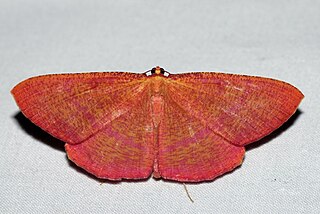
Eumelea is a genus of moths in the family Geometridae. It was described by James Duncan and John O. Westwood in 1841. Species are confined to Austro-Malayan subregions and throughout China, India, Sri Lanka and Myanmar.

Dysphania militaris is a species of moth of the family Geometridae that is found from in the tropical regions of South and Southeast Asian countries such as China, India, Myanmar, Andaman Islands, Sumatra and Java. It was first described by Carl Linnaeus in his 1758 10th edition of Systema Naturae.

Eumelea rosalia is a species of moth of the family Geometridae described by Caspar Stoll in 1781. It is found from the Indo-Australian tropics of India, Sri Lanka, Myanmar, east to northern Australia and New Caledonia.

Dysphania percota, the blue tiger moth, is a moth of the family Geometridae that can be found in India. It was first described by Charles Swinhoe in 1891.
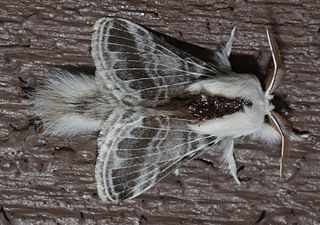
Tolype velleda, the large tolype moth or velleda lappet moth, is a species of moth of the family Lasiocampidae. It was first described by Caspar Stoll in 1791. The species is found from Nova Scotia to central Florida, west to Texas and north to Ontario.

Nyctemera coleta, the marbled white moth or white tiger moth, is a moth found from India to the Philippines, and from Japan to Papua New Guinea. It is classified under the subgenus Coleta of the genus Nyctemera in the family Arctiidae. The species was first described by Caspar Stoll in 1782. It contains four subspecies.

Cyclosia panthona is a moth in the family Zygaenidae. It was described by Caspar Stoll in 1780. It is found in China, Hong Kong, India, Sri Lanka, and Myanmar.

Hyperythra lutea is a moth in the family Geometridae. The species was first described by Caspar Stoll in 1781. It is found in Indian subregion, Sri Lanka, South East Asia, Sundaland.
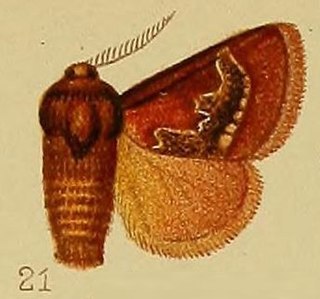
Miresa is a genus of moths in the family Limacodidae described by Francis Walker in 1855.
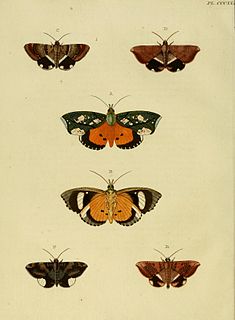
Achaea mezentia is a moth of the family Erebidae first described by Caspar Stoll in 1780. It is found in India and Sri Lanka.
Nygmia icilia is a moth of the family Erebidae first described by Caspar Stoll in 1790. It is found in India and Sri Lanka.
Dysphania prunicolor is a moth of the family Geometridae first described by Frederic Moore in 1879. It is found in India and may be found in Sri Lanka.
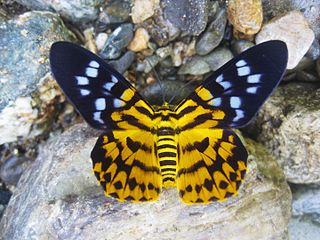
Dysphania subrepleta is a species of false tiger moth in the subfamily Geometrinae. Records are from Indo-China and western Malesia including Borneo, with no subspecies listed in the Catalogue of Life, where it is a "provisionally accepted name".













